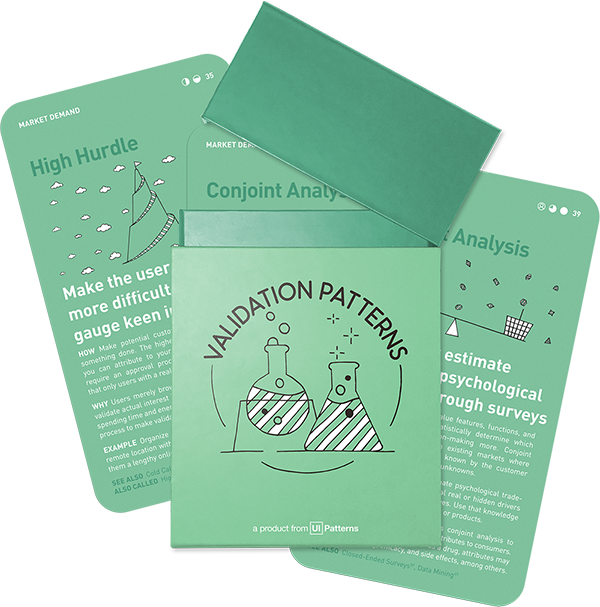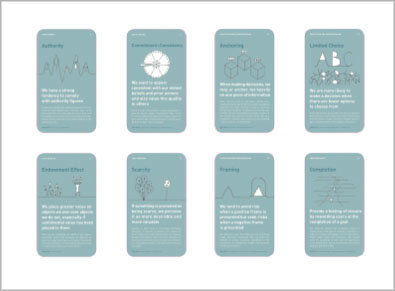Idea Validation: Market demand, Willingness to pay
Referral Program
Evaluate customer willingness to refer friends

How: Identify and target customers who are likely to advocate your product and set up referral codes and analytics to track share rate, click-through rate, and conversion rate. Consider how to incentivize both the advocate customer for the referral and the friend for signing up.
Why: When customers are willing to advocate a product to their friends in high numbers, it is strong evidence that the business is ready to scale organically.
When building new products or refining go-to-market strategies, it’s easy to focus all efforts on paid acquisition channels and top-of-funnel metrics. But growth isn’t just about visibility—it’s about trust. And one of the clearest indicators of trust is when existing users refer others to your product. A referral program, designed and deployed as a lean experiment, offers product teams a structured way to test customer willingness to promote a solution to their peers.
“A referral program is more than a growth hack”
Unlike full-scale viral growth strategies that require time and infrastructure, a lean referral experiment is minimal and fast. The goal isn’t to engineer exponential loops right away—it’s to measure advocacy. Will people talk about your product? Are they excited enough to bring others in? Would they vouch for you if there’s something in it for them—or even if there isn’t?
Why run a Referral experiment?
Referral programs help teams answer an essential question early: Are our customers so satisfied that they’ll tell others? This method gives insight into product-market fit, customer loyalty, and the organic potential of your product. If people refer you, they trust you. If they refer you with an incentive, they believe the experience is worth sharing.
From a lean perspective, referral programs are useful because they test multiple assumptions at once:
- That the product delivers enough value to be recommended.
- That customers have others in mind who would benefit.
- That incentives (if used) are motivating and easy to redeem.
Whether used as a standalone experiment or part of a broader acquisition strategy, referral tests can be a powerful signal of whether your experience is creating delight—or just satisfaction.
Designing the Referral test
The lean version of a referral program starts small. It might be a basic form with a unique code, a pop-up prompt after a success moment, or an email campaign inviting users to share with friends. What matters is not sophistication, but whether people engage with the mechanism.
Your first version could offer a simple incentive—a discount, early access, credits, or even just recognition. Many companies use double-sided incentives: both the referrer and the referee receive something. Dropbox’s free space, Uber’s ride credits, and Airbnb’s travel vouchers are now classic examples.
There are several types of referral programs to consider, depending on your product and user behavior:
- Single-sided incentive programs, where only the referrer is rewarded.
- Double-sided programs, where both referrer and referee benefit.
- Tiered programs, where rewards increase with the number of successful referrals.
- Leaderboards, recognizing top referrers.
- Affiliate or ambassador programs, where participants promote the product publicly for ongoing perks.
- NPS-based programs, targeting users who already rate you highly.
- Content-based programs, where sharing specific posts or testimonials counts as a referral.
To design the test, ask:
- Where in the user journey does it make sense to ask for a referral?
- What’s the simplest way to track successful referrals?
- What message makes this feel like an opportunity—not a sales push?
You don’t need a custom-built infrastructure to begin. Tools like ReferralCandy, Viral Loops, or even a Google Form can help you track interest. What matters is fast feedback: are people responding?
Examples of successful product referral programs
Some of the most successful startups tested referral behavior early, long before investing in scale.
Dropbox famously grew its user base 60% by offering additional storage space for referrals. This worked because the reward was aligned with user needs and required minimal effort.
Airbnb’s early referral system underperformed until they optimized visibility and messaging. After integrating it into their UI and mobile experience—and offering dual travel credits—it became a major driver of growth.
Buffer and PayPal both leaned on simple referral flows in their early stages to validate product appeal and encourage low-cost acquisition. Tesla used tiered rewards and exclusives to make referrals aspirational, reinforcing brand status while encouraging peer-to-peer promotion.
These programs weren’t always successful on the first try. Each company learned by testing and iterating: making the reward more desirable, improving timing, simplifying steps, or personalizing the message.
How to measure referral success
A lean referral experiment is not about scale, but signals. You’re looking for early indicators of behavioral intent:
- How many users share a referral?
- How many recipients convert?
- What are the activation or retention rates of referred users?
If referral engagement is high, that’s a green light to explore scaling. If it’s low, don’t assume the product failed—look at the context. Was the incentive relevant? Was the ask too early? Did the mechanics create friction?
Also watch for qualitative indicators: Did users ask for a way to refer others before you offered it? Do they mention sharing your product organically?
Referral Programs as product discovery
What makes referrals uniquely valuable in discovery is that they expose how much users believe in your product—not just how much they use it. People don’t recommend mediocre experiences to their friends. So if you observe strong referral intent, you’re seeing real-world product-market fit signals.
Referral experiments can also uncover which features or experiences spark the most enthusiasm. For example, if referrals spike after users complete a particular task or hit a milestone, that’s a signal worth building around.
Use referrals as a moment to talk to your customers. Why did they share? What would make them do it again? What was the easiest part—or the part that felt off? These are insights you can use not just to grow, but to improve core value delivery.
The 3Rs framework is a useful tool here:
- Return: Do users come back and re-engage with the product?
- Rate: Are users rating or reviewing your product positively?
- Refer: Do they take the final step to refer others?
This sequence can help you identify when users are most ready to refer—and whether foundational engagement is strong enough to support a program.
Getting it right
Not every product is inherently referable. If you’re in a sensitive space (e.g., financial distress, health, privacy), people may not want to reveal their use to others. And some audiences just don’t think in networks. That’s why referral experiments should be framed as tests, not guarantees.
It’s also easy to mistake incentives for advocacy. If someone shares a code for $10 off, that doesn’t always mean they believe in your product. That’s why it’s important to monitor downstream behavior and qualitative feedback—not just raw referral counts.
At worst, referral programs can feel spammy if overdone. Respect user experience, and focus on genuine value—not just pushing growth.
When to run a Referral experiment
Referral testing makes the most sense when:
- You have early active users or beta testers with strong engagement.
- You’re seeing signs of satisfaction but want to measure advocacy.
- You’re looking to validate a new acquisition channel without major investment.
Pair referral experiments with:
- Net Promoter Score (NPS) surveys to predict referability.
- Usability testing to identify friction before asking for shares.
- Email marketing to test different messages or reward structures.
- Onboarding analysis to identify when users hit their first “aha” moment.
Used thoughtfully, referral testing isn’t just about viral loops—it’s about trust, timing, and value alignment.
More than a growth hack
A referral program is more than a growth hack. It’s a lens into whether people care enough to invite others. In the context of product discovery, that’s a powerful signal. It tells you what’s resonating, what’s worth amplifying, and what barriers might still stand in the way of word-of-mouth.
Run it lean. Run it fast. Run it honestly. Then use what you learn not just to grow, but to deepen your product’s relevance in people’s lives.
Popular tools
The tools below will help you with the Referral Program play.
-
ReferralCandy
A plug-and-play referral platform designed for e-commerce and SaaS businesses, enabling simple setup of single or double-sided referral programs.
-
Viral Loops
Flexible referral program builder offering templates for waitlists, leaderboards, and prelaunch campaigns, making it suitable for startups and MVPs.
-
Friendbuy
Referral platform for growth-focused teams, allowing dynamic reward structures and real-time analytics to validate incentive effectiveness.
-
Postscript
Optimized for SMS marketing and referral tracking, this tool is ideal for DTC brands looking to test viral loops directly within text-based channels.
-
SaaSquatch
Enterprise-grade referral and loyalty platform built for subscription businesses and SaaS products, with robust experiment tracking.
Real life Referral Program examples
Dropbox
As a user of Dropbox’ file hosting service, customers can earn additional hosting space by inviting friends to use the service as well. Several numbers are evidence of good desirability and viability: The ratio between total customers and how many customers actively invite friends and the advocate share rate: the ratio between codes shared and codes used.
Source: growsurf.com
Source: growsurf.com
Source: referralcandy.com
A collection of 60 product experiments that will validate your idea in a matter of days, not months. They are regularly used by product builders at companies like Google, Facebook, Dropbox, and Amazon.
Get your deck!Related plays
- Testing Business Ideas by David J. Bland & Alexander Osterwalder
- Building a Referral Feature, MVP Style by Nils Stotz at Medium
- How Airbnb Built One of the Most Successful Referral Programs Ever at CloudSponge
- How to Utilize the Lean Startup Methodology at Business.com
- How to Establish a Marketing Presence as a Lean Startup at StartupNation
- Real-World Example: A Lean Startup Success Story at Vizologi
- Driving Growth Through Referral Programs by Shehab Beram at LogRocket
- What are the best referral program examples for startup user acquisition and growth? at Quora

